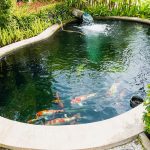Adding an inground pond to your backyard can create a beautiful and serene oasis, providing a focal point for relaxation and enjoyment. Whether you’re looking to enhance the natural beauty of your garden or create a tranquil retreat, building an inground pond can be a rewarding and fulfilling project. In this comprehensive guide, we’ll walk you through the step-by-step process of building your very own inground pond.
Step 1: Planning and Design
Before you begin digging, it’s essential to carefully plan and design your inground pond. Consider the size and shape of the pond, as well as its location in your yard. Take into account the surrounding landscape and any existing features, such as trees or flower beds, that could complement the pond’s design.
Sketch out a rough design, taking note of any specific features you’d like to incorporate, such as waterfalls, fountains, or aquatic plants. This initial planning stage will help you visualize the end result and ensure that your pond fits seamlessly into your outdoor space.
Step 2: Choosing the Right Location
When selecting a location for your inground pond, consider factors such as sunlight exposure, proximity to trees, and drainage. Aim to place the pond in an area that receives a good balance of sunlight and shade throughout the day, as this will support a healthy ecosystem for aquatic plants and fish.
Additionally, it’s important to avoid areas with overhanging trees, as falling leaves can create maintenance challenges and potentially harm the pond’s water quality. Finally, ensure that the chosen location has adequate drainage to prevent water runoff from damaging the surrounding landscape during heavy rain.
Step 3: Excavation
Once you’ve planned and designed your pond, it’s time to start digging. Using a shovel or a mechanical excavator, carefully excavate the area according to the dimensions and shape of your pond. As you dig, be mindful of creating shelves or varying depths to accommodate different types of aquatic plants and provide refuge for fish.
It’s crucial to remove any sharp rocks, roots, or debris from the excavation site to create a smooth and stable base for your pond. Take your time with this step, as the quality of the excavation will greatly impact the overall success and longevity of your inground pond.
Step 4: Installing the Pond Liner
Once the excavation is complete, it’s time to install the pond liner. Choose a high-quality, durable liner that is specifically designed for inground ponds. Lay the liner carefully into the excavation, ensuring that it covers the entire surface and extends up the sides of the pond.
Smooth out any wrinkles or folds in the liner to create a seamless and watertight barrier. It’s also a good idea to use an underlayment material, such as geotextile fabric, to protect the liner from punctures or damage caused by rocks or roots in the soil.

Credit: www.youtube.com
Step 5: Adding Filtration and Circulation Systems
Creating a healthy and balanced ecosystem within your inground pond requires adequate filtration and circulation. Install a suitable filtration system, such as a biological filter or a UV clarifier, to maintain water clarity and purity. Additionally, consider incorporating a water pump to circulate the water and prevent stagnation.
These systems will help keep the water clean and oxygenated, promoting the growth of beneficial bacteria and supporting the overall health of any fish or aquatic life in the pond. Proper filtration and circulation are essential for maintaining a thriving and vibrant ecosystem within your inground pond.
Step 6: Landscaping and Finishing Touches
With the basic structure of the pond in place, it’s time to add the finishing touches that will truly bring your inground pond to life. Consider landscaping around the pond with a variety of plants, such as water lilies, lotus, and cattails, to create a natural and visually appealing environment.
You can also add decorative elements, such as rocks, driftwood, or statues, to enhance the aesthetic appeal of the pond and create a sense of tranquility. Don’t forget to consider lighting options, such as underwater LED lights or landscape spotlights, to enjoy the beauty of your pond even after the sun sets.
Step 7: Introducing Aquatic Life
If you’re interested in adding fish or other aquatic life to your inground pond, it’s important to carefully introduce them into their new environment. Choose fish species that are well-suited to the size and conditions of your pond, and gradually acclimate them to the water temperature and quality.
Ensure that your pond has adequate shelter and hiding places for fish, such as submerged plants or rock formations. Additionally, consider adding aeration devices, such as a fountain or air stone, to provide oxygen and maintain a healthy environment for the aquatic life in your pond.
Step 8: Maintenance and Care
Once your inground pond is complete, regular maintenance and care will be essential to ensure its long-term health and beauty. Establish a routine for cleaning debris, checking and maintaining filtration systems, and monitoring water quality parameters, such as pH and ammonia levels.
Seasonal maintenance tasks, such as trimming aquatic plants and protecting the pond from freezing during winter, will also be necessary to keep your pond in optimal condition. By staying on top of maintenance, you can enjoy a thriving and vibrant inground pond for years to come.

Credit: empressofdirt.net
Conclusion
Building an inground pond can be a fulfilling and rewarding project that adds a touch of natural beauty and tranquility to your outdoor space. By carefully planning, designing, and implementing each step of the process, you can create a stunning and thriving pond that enhances your landscape and provides a peaceful retreat for relaxation and enjoyment.
Remember to consider the size, location, and design of your pond, as well as the essential elements of filtration, circulation, and landscaping. With proper care and maintenance, your inground pond can become a captivating focal point in your backyard, creating a serene and harmonious environment for both you and the wildlife it attracts.




